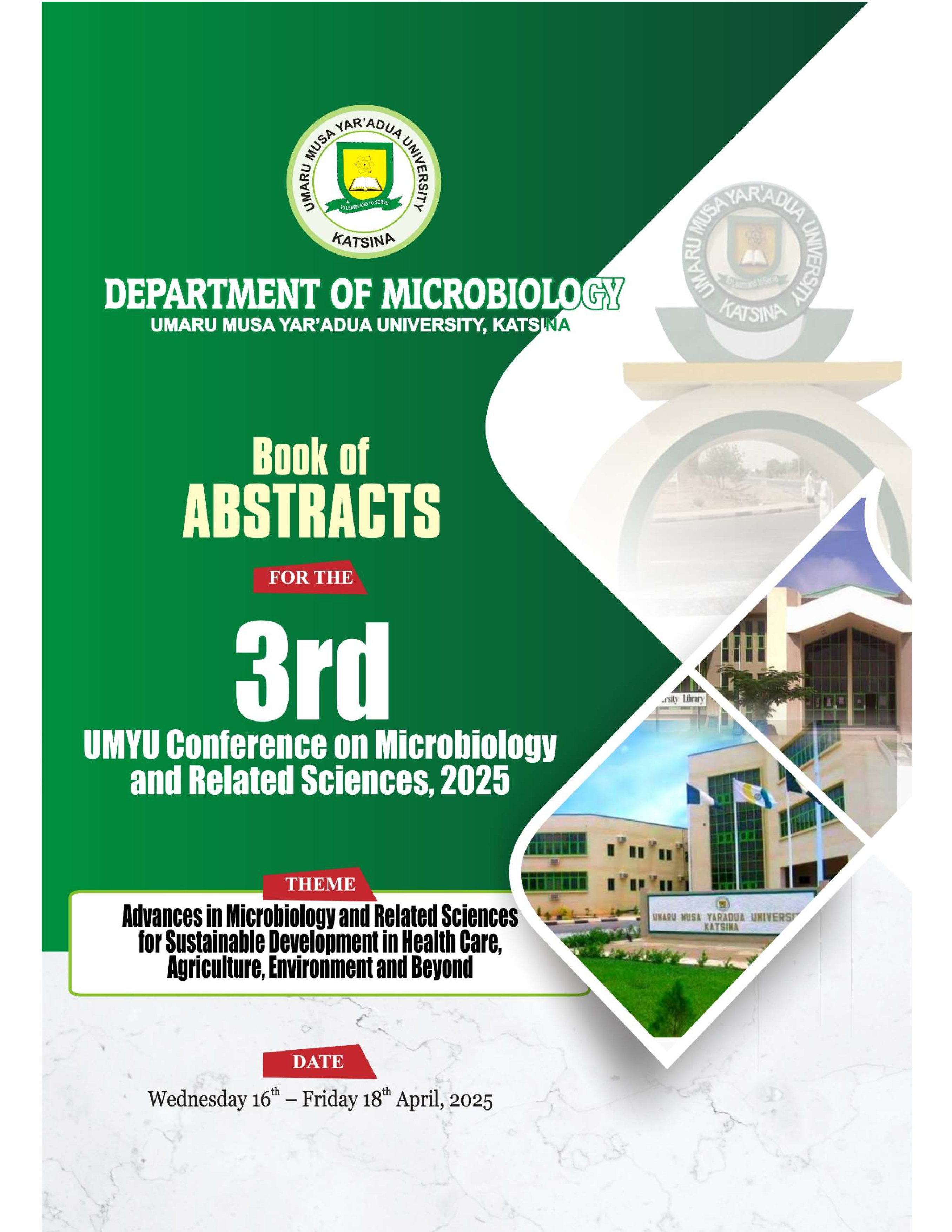Impact of Extraction Solvent on Phytochemical Profile and Antifungal Efficacy of Vitellaria paradoxa Leaf Extracts against Candida albicans, Trichophyton rubrum, and Microsporum canis
DOI:
https://doi.org/10.47430/ujmr.25103.031Keywords:
Antifungal, Extraction, Infections, Phytochemicals, SolventAbstract
Study’s Excerpt:
- Methanolic extract of paradoxa showed potent antifungal activity.
- Aqueous extract exhibited limited inhibition against test fungi.
- M. canis was most susceptible (19.0 ± 2.00 mm) to methanolic extract.
- Glycosides and carbohydrates were found only in methanolic extract.
- Solvent choice significantly affected antifungal efficacy (p = 0.049).
Full Abstract:
The increasing resistance of fungal pathogens to conventional antifungal drugs necessitates the search for alternative therapeutic agents. Vitellaria paradoxa has been recognised for its medicinal properties, but solvent-dependent variations in its antifungal potency remain underexplored. This study investigated the phytochemical composition and antifungal efficacy of methanolic and aqueous extracts of V. paradoxa leaves against Candida albicans, Trichophyton rubrum, and Microsporum canis. Fungal isolates were obtained from the previously stocked samples in the Microbiology Laboratory, Bauchi State University, Gadau, while V. paradoxa leaves samples were purchased from Azare Central Market. Phytochemical screening of the leaves was performed using standard qualitative methods, while antifungal efficacy was assessed through the disc diffusion technique. Phytochemical screening revealed both both extracts contained alkaloids, flavonoids, tannins, steroids, and phenols, while glycosides and carbohydrates were detected only in the methanolic extract, and saponins were exclusive to the aqueous extract. Antifungal susceptibility testing demonstrated that methanolic extracts exhibited significantly higher potency, with inhibition zones reaching 19.0±2.00 mm against M. canis at 200 mg/mL, whereas the aqueous extract showed minimal inhibition. The methanolic extract also had lower minimum inhibitory concentrations (MIC) and minimum fungicidal concentrations (MFC), suggesting greater efficacy in disrupting fungal growth. Statistical analysis (ANOVA, p = 0.049) confirmed a significant difference between the efficacy of the methanolic and aqueous extracts. These findings highlighted the importance of solvent choice in optimising antifungal activity and suggested that methanolic extracts of V. paradoxa may serve as a potential alternative to synthetic antifungal agents.
Downloads
References
Abdul-Hammed, M., Jaji, A. O., & Adegboyega, S. A. (2020). Comparative studies of thermophysical and physicochemical properties of shea butter prepared from cold press and solvent extraction methods. Journal of King Saud University - Science, 32(4), 2343–2348. https://doi.org/10.1016/j.jksus.2020.03.012
Adam, A. A., & Omogbene, T. O. (2020). Phytochemical and phytomineral (macro and trace) compositions of the leaf, stem bark and root of Blighia sapida K.D. Koenig. Journal of Medicinal Plants Studies, 8(5), 20–24. https://doi.org/10.22271/plants.2020.v8.i5a.1190
Adam, S. I., Hassan, A. B., & Magaji, A. (2023). Comparative phytochemical screening of methanolic and aqueous leaf extracts of Vitellaria paradoxa. International Research Journal of Chemistry, 11(2), 78–85. https://petsd.org/ojs/index.php/irjc/article/view/1702
Babarinde, T., Adesola, A., & Oladapo, K. (2023). Antimicrobial efficacy of methanolic fraction of shea nut on selected skin pathogens and characterization of bioactive compounds. Journal of Pharmaceutical and Chemical Research, 15(1), 65–72. http://www.jocronline.com/jpcr/article/view/6572
Bertrand, W. F., Thais, L. T., Roland, D. M., Rasmané, S., Touridomon, I., & Sabine, D. (2021). African Shea Butter properties related to common extraction technologies: A review. Food and Bioprocess Technology, 1–19. https://doi.org/10.1007/s11947-021-02708-w
Boyejo, A. O., Kayode, O. T., & Omobuwajo, T. O. (2019). Comparative analysis of the chemical composition of Vitellaria paradoxa nut fat from East and West Africa. International Journal of Food Science, 54(3), 219–228. https://doi.org/10.1055/s-0043-111122
Catteau, L., Zhu, L., Van Bambeke, F., & Quetin-Leclercq, J. (2017). Plant-derived triterpenoids as potential resistance-reversing agents against methicillin-resistant Staphylococcus aureus (MRSA). Planta Medica, 83(8), 662–674. https://doi.org/10.1055/s-0043-111122
Ekhuemelo, D. O., Amonum, J. I., & Ogundipe, O. T. (2021). Antifungal effects of Vitellaria paradoxa fractions on wood-decay fungi. Nigerian Journal of Biotechnology, 38(2), 78–84. https://doi.org/10.4314/njb.v38i1.1
Fodouop, S. P. C., Gatsing, D., Tangue, B. T., Tagne, R. S., Tala, S. D., Tchoumboué, J., & Kuiate, J. R. (2015). Effect of Salmonella typhimurium infection on rat's cell oxidation and in vivo antioxidant activity of Vitellaria paradoxa and Ludwigia abyssinica aqueous extract. Asian Pacific Journal of Tropical Diseases, 5(1), 38–46. https://doi.org/10.1186/s12906-017-1643-1
Iddrisu, A.-M., Didia, B., & Abdulai, A. (2019). Shea butter extraction technologies: Current status and future perspective. African Journal of Biochemistry Research, 13(2), 9–22. https://doi.org/10.5897/AJBR2018.1007
Kalgo, M. U., Hamid, K. M., Muhammad, U. A., Balarabe, A., Yeldu, M. H., Yahaya, I. S., Kalgo, Z. M., Aliyu, B., & Bala, Y. G. (2019). Effects of aqueous stem bark extract of Vitellaria paradoxa on human neutrophil function and viability. International Journal of Biological & Medical Research, 10(3), 6782–6787. https://www.biomedscidirect.com/download/IJBMRF20192523/13/effects-of-aqueous-stem-bark-extract-of-vitellaria-paradoxa-on-human-neutrophil-function-and-viability.pdf
Koudou, J., Abena, A. A., Ngaissona, P., & Bessière, J. M. (2020). Chemical composition and pharmacological properties of essential oils from African medicinal plants. Phytotherapy Research, 34(8), 1895–1903. https://doi.org/10.1002/ptr.6661
Lawal, I. O., Olufade, I. I., Rafiu, B. O., & Aremu, A. O. (2020b). Ethnobotanical survey of plants used for treating cough associated with respiratory conditions in Ede South local government area of Osun state, Nigeria. Plants, 9(5), 647. https://doi.org/10.3390/plants9050647
Lawal, I., Omogbene, T., & Adam, A. (2020a). Phytomenadione as a dietary supplement: Sources and health benefits. In Preparation of phytopharmaceuticals for the management of disorders (pp. 381–389). Elsevier. https://doi.org/10.1016/B978-0-12-820284-5.00023-X
Magaji, A., Mahmud, Z., & Mustapha, A. (2023). Phytochemical analysis and assessment of antibacterial efficacy of Vernonia amygdalina (Bitter Leaf) against some selected clinical bacterial isolates. UMYU Journal of Microbiology Research, 8(2), 174–180. https://doi.org/10.47430/ujmr.2382.020
Mahmud, Z., Magaji, A., Luka, N. K., Bilyaminu, U., Aliyu, A. J., & Abubakar, Z. M. (2025). GC-MS profiling and in vitro antifungal efficacy of Vitellaria paradoxa oil against dermatophytes and yeasts. UMYU Scientifica, 4(2), 200–205. https://doi.org/10.56919/usci.2542.021
Zhang, J., Zhang, Y., & Jin, L. (2018). Therapeutic potential of Shea butter-derived compounds in dermatology and infectious diseases. Journal of Ethnopharmacology, 223, 148–159. https://doi.org/10.1016/j.jep.2018.05.028
Downloads
Published
How to Cite
Issue
Section
License
Copyright (c) 2025 Auwal Magaji, Nathaniel Kwarau Luka, Adamu Yakubu, Zailani Liman Hafiz

This work is licensed under a Creative Commons Attribution-NonCommercial 4.0 International License.




